“They can spell the words during word study, but then it doesn’t transfer!”
Have you found yourself saying this before? If you’re like me, you’ve seen students appear to have mastered a spelling pattern or word family during phonics/word study…but then they spell it incorrectly in their writing. Or they don’t use that knowledge in their reading.
Lack of transfer between word work, reading, and writing can definitely be frustrating—and a little confusing.
After all, the purpose of phonics or word study is to help our students become successful readers and writers. But if that learning doesn’t transfer…then what’s the point?!
The issue of transfer is definitely not a challenge that I’ve completely overcome. But it’s something that I’m working on, so I’d like to share with you what I’ve learned and what I’m trying with my own students.
In this post, I’ll explain why transferring word learning is particularly difficult when it comes to writing. (This made me feel a little better about my own struggles!) I’ll also share some strategies to help your students use their word study knowledge to become stronger readers and writers!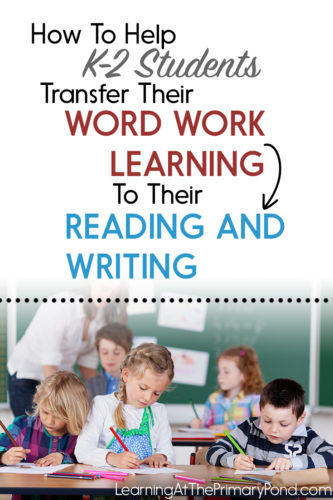
Photo Credit; stockfour, Shutterstock
Why do kids tend to misspell words in their writing, when they can spell those same words correctly during word study?
In my intervention work, I sometimes go straight from a word study activity into a writing activity…and the student ends up spelling words incorrectly that she had appeared to have mastered 5 minutes ago! ?
So why does that happen? I’ve been curious about this for the longest time, but (I think) I’ve finally found an answer. And it makes a whole lot of sense:
“[T]he process of crafting written texts is widely understood as being multidimensional (Hayes & Berninger, 2014). Hence the coordination of a range of writing elements (e.g., vocabulary selection, sentence structure, generation of ideas, handwriting, or touch-typing) requires greater cognitive load when composing extended texts (Williams & Lundstrom, 2007). It is possible that, due to the cognitive demands associated with composing larger texts, spelling errors are more likely to occur” (Daffern, 2017, p. 428-429).
In a nutshell…this quote asserts that because so many mental processes are required for writing, students have less attention freed up to focus on spelling words correctly. Some of our little ones struggle to just plan and remember a sentence, so it makes sense that they might not be focused on spelling words correctly!
This quote also made me think that transfer has a lot to do with levels of automaticity.
The better a child knows a word pattern, the more likely he is to write it correctly, even when he must focus on other considerations when he’s writing.
To make this concrete, I’ll use an example from my own life: learning to play tennis. I played a lot of tennis when I was younger, particularly in high school.
During practices, we did drills. We would work on forehand technique, for example. With my coach’s help, I could get to a point where I was hitting consistently strong forehands.
But during a competitive match? That’s a whole other story! It was SO much harder to apply those skills that I thought I’d learned. I was focused on other things—the wind, what my opponent was doing, not tripping over my own two feet as I ran around the court. ?
You get the picture; it’s much easier to demonstrate mastery in an isolated situation than it is to transfer those skills to a multidimensional, unstructured situation.
There are varying levels of mastery, even when a student does extremely well with out-of-context practice. It can be difficult to figure out what “level” that student is at.
BUT the more you practice, the more fluent you become with a skill (whether it’s spelling the -at word family or hitting forehands on the tennis court), and the easier it becomes to use that skill in a different situation.
So it seems to come down to fluency and automaticity.
Maybe that means we need to stick with one word feature or pattern a little longer than we might normally do so—to help get our kids to the point where they are fluent with that feature (and therefore able to apply that knowledge in other contexts).
I also think it means that we need to be patient and provide our students with enough time to develop that automaticity, since it doesn’t happen overnight.
How can I teach for transfer?
All of that said, there are still things we can do to help our students transfer their word work learning. Here are some ideas:
- Teach students to compare and contrast words. Instead of having students spell a list of words with long o and a silent e, have them work with some of these words AND some words with a short o.
- Create less structured opportunities for students to explore words. The Making Words activity by Patricia Cunningham is one that allows students to explore letters, patterns, and try to make new words. Of course, the teacher provides guidance and ensures that a productive discussion takes place. But this type of activity encourages students to make connections more so than does, for example, a worksheet that only covers words with the -ay spelling pattern.
- Revisit spelling patterns that you previously taught. If you have taught blends a few months ago and are working on long vowel spelling patterns, have students work with words that have long vowels AND blends. You may find that you need to go back and review previous patterns, too, if students haven’t achieved complete automaticity with them.
- Make sure you discuss words and their features during every part of the school day. Whether you’re working on a math journal entry or reading a story during shared reading, it only takes a second to point out your noticings or ask students what they notice. This will help them understand that readers and writers are always thinking about words and spelling.
- Teach students the “try it both ways” method for spelling words. If they come to a word and are not sure how to spell it, have them write it on a sticky note. They write the word 2+ different ways, using their spelling pattern knowledge, and then decide which way looks right. For example, if a child is not sure how to spell “feel,” she might write “feal” and “feel” on the sticky note before adding the correct spelling to her piece of writing. This is especially effective with sounds that have multiple spelling pattern options, like vowel teams!

- When you have students edit their writing, have them read through it once looking only for spelling mistakes. I’ve found that having students read their writing (or a partner’s) multiple times is extremely valuable. We read once for capitalization, once for organization (neatness / paragraphing / handwriting), once for punctuation, and once for spelling. It’s usually too much to ask little ones to focus on all of those things at once!
- Have students find examples of words (with the features they’re studying) in real texts. I like to have students complete this activity with their book bag books!

Conclusions
Getting our students to transfer their word learning takes time, patience, and our own recognition that there are different (and sometimes hard to discern) levels of mastery for any skill.
If you have any other “transfer-focused” activities to add to this list, I would love to hear them!
Also…I have a big word work announcement to share with you next week, so be sure to check back then!!
References
Daffern, T. (2017). What Happens When a Teacher Uses Metalanguage to Teach Spelling? The Reading Teacher, 70(4), 423–434.

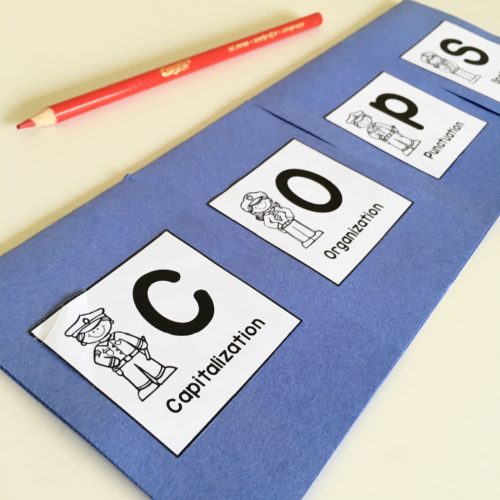
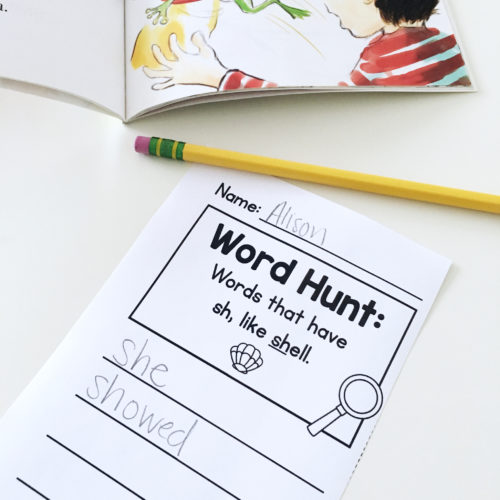

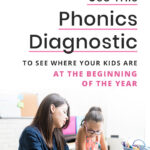
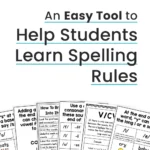
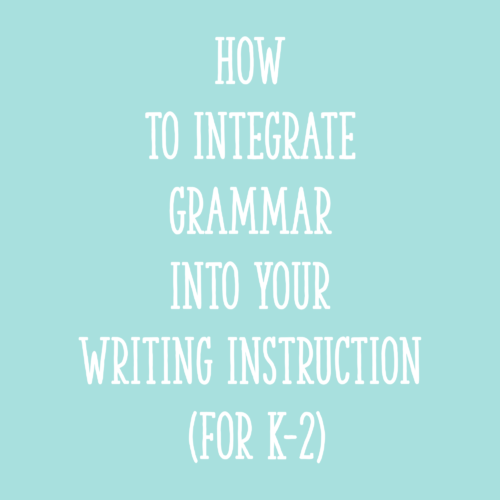
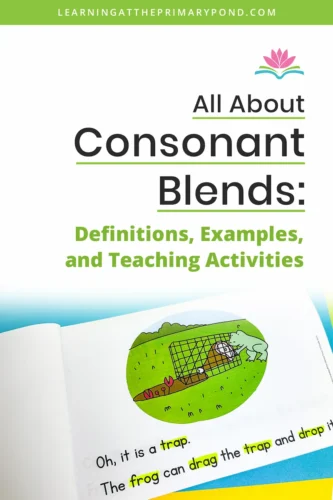







Alison, this is a huge problem in my first grade class. Not only do they forget to transfer the word work patterns to writing but to reading. I really like your ideas on editing. I am going to have them find examples in text as part of word work and guided reading. I am starting to think that this will help. Thanks
Hi Celeste! I hope those strategies help – let me know how it goes!
Alison
Thanks for your insight. It makes a lot of sense when it’s explained like that. Loved your tennis analogy and the Cunningham strategy.
Hey Heidi! So glad this was helpful! Thanks for reading! 🙂
Alison
I found your article extremely helpful since ny students have the problem. Thanks
Thanks for this article Alison. It is certainly extremely frustrating when the skills don’t transfer and that’s a problem we see time and time again. Of course it compounds the problem if a child is struggling with literacy too. I take your point about automaticity as well. I do a lot of repetition in my class, repeating the same concept in a variety of activities to cater for different learners but I think I will add in my learning intentions that we are trying to use these words and patterns when we read and write. I don’t think I’ve ever… Read more »
Hey Lyn! I’m glad this was helpful!
And it’s so easy to forget little things like that, right?!
Alison
Your blog is so very helpful, even for seasoned teachers. I am anxious to share it with my colleagues! Thank you for generously sharing your expertise.
Thank you so much, Laura!!
Alison
Thanks for that information, I was struggling with this in my class, where the children don’t transfer their word attack skills to reading and writing. Thanks again
Absolutely love this article! Thank you.
These are great! Where is the word hunt activity from?
Thanks, Corey! That comes from this resource: https://www.teacherspayteachers.com/Product/Word-Work-Center-Activities-for-First-Grade-3390450
Alison
I am windering if students could voice record their writing and use it to either write the story or make corrections to a piece of writing. This way they can focus on writing the words or looking for errors instead of spending energy trying to write and create/read at the same time.
Hey Michelle! I have not tried this myself but I LOVE that idea!
Alison
Nice article with a lot to consider – thank-you for highlighting so many facets of spelling and writing. I also find that kids also have to concentrate on so much more when writing as it involves posture, co-ordinating the arms to hold the book and the pencil, shoulder muscles to anchor the arm to allow the other arm and hand muscles to write.
So very true, Anne! It’s a lot for little ones to master!
Alison
Amazing advice! That makes so much sense. I’ve always wondered the same thing. Thank you for sharing this.
this was meaningful with good ideas, thanks
Brilliant idea! Thank you for sharing this with us.
Thank you for a great article and explanation. With regards to writing, I wonder if kiddos have automaticity with their letter writing ability, if that helps too?
I love the COPS idea for kiddos to use to reread their writing multiple times checking for capitalization, organization, punctuation and spelling. Is that available on your tpt site?
Hey Lenore! So glad this was helpful! I definitely think that automaticity with letter writing helps, too. And definitely takes time!
Here’s the link for the resource that has the COPS editing book: https://www.teacherspayteachers.com/Product/Revising-and-Editing-Toolkit-for-Kindergarten-First-and-Second-Grade-2157283
Alison
I never comment, but I want to say that I’ve become a better teacher thanks to what I learn from this blog. Thanks a lot.
That makes me so happy – THANK YOU for commenting!
Alison
Thanks Alison. Lots of great ideas here. Do you have any suggestions for words that are high frequency/ sight words e.g. there, they, where, were, was, said. I teach middle primary and still have kids reverting back to spelling these words incorrectly when writing more substantial pieces of writing.
Thanks.
Hey Petra! Have you tried using a personal sight word dictionary or word wall that students are always held accountable for spelling correctly?
Alison